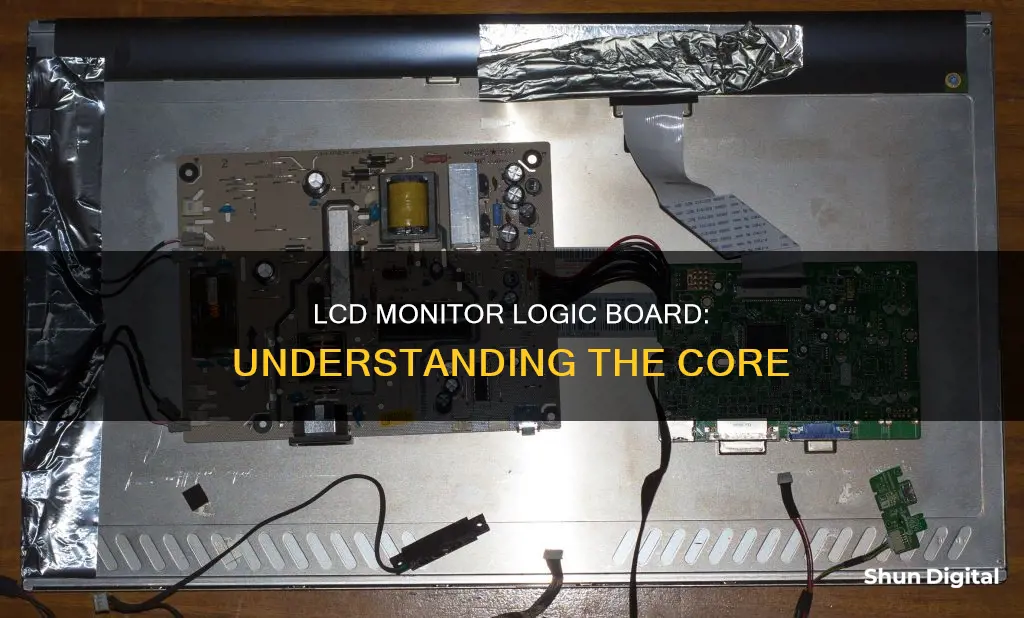
An LCD controller board is a piece in an electrical circuit that interfaces with a peripheral object by connecting the computer to it. The LCD controller board is often called the Analog/Digital (A/D) board. It allows for various video source inputs to be connected, selected, and displayed on the LCD screen. It does this by converting the different video input signals into a format manageable by the LCD panel.
| Characteristics | Values |
|---|---|
| Purpose | A controller board is a piece in an electrical circuit that interfaces with a peripheral object by connecting the computer to it |
| Connection | The connection may be with other computer parts, such as the memory controller, or with an external device, like a mouse, that acts as a peripheral controller for an operation of the original device |
| Input signals | VGA, HDMI, DVI, and DisplayPort |
| Output interfaces | Low-voltage differential signaling (LVDS), SPI, I2C, and Parallel |
| Other input/output systems | Controlling and monitoring options, such as controls for brightness, image, and color using the on-screen display (OSD) control panel |
| Communication | Ethernet, Bluetooth, or IP |
| Built-in inverter | Enables the lighting and powering of the LCD’s backlight |
| Built-in RAM | Stores the contents of the display |
What You'll Learn
- The LCD controller board is often called the Analog/Digital (A/D) board
- The LCD controller board allows for various video source inputs to be connected, selected, and displayed on the LCD screen
- The LCD driver is a form of software that is the interface of and dependent on the controller piece
- The LCD controller/driver adjusts the input signal, scaling resolution if needed, and then outputs the signal for the LCD monitor to use
- The LCD board also contains an inverter that enables the lighting and powering of the LCD’s backlight

The LCD controller board is often called the Analog/Digital (A/D) board
The LCD controller board, also known as the Analog/Digital (A/D) board, is an essential interface for LCD monitors and displays. It is a hardware processor that allows various video source inputs to be connected, selected, and displayed on an LCD screen. This is achieved by converting different video input signals into a format that can be managed by the LCD panel.
The LCD controller board accepts a range of video signal inputs, including HDMI, DisplayPort, DVI, ARGB (VGA), Component video, Composite video, HD-SDI, and HD-BaseT. It then formats the signal, scales the resolution if necessary, and outputs a suitable format signal to the LCD panel, such as LVDS, V-by-One, eDP, and TTL.
Additionally, the LCD controller board offers control functions and monitoring options, such as brightness, image, and colour controls, as well as advanced functions like picture-in-picture. It also includes various methods of control, such as buttons and RS-232. Sensors and other functions can further enhance the functionality of the display system.
The LCD controller board is commonly used in a wide range of applications, including computer monitors, in-flight entertainment systems, navigation systems, medical devices, industrial equipment, and public digital signage.
Commercial LCD controller boards, designed for non-consumer products, are manufactured with higher reliability standards and specific functions for applications in industries such as aviation, marine, medical, industrial, security, and digital signage. They also offer longer production life cycles, customisation options, and are suitable for harsh environments.
Monitors for Horizontal Setups: 27-Inch Options and Beyond
You may want to see also

The LCD controller board allows for various video source inputs to be connected, selected, and displayed on the LCD screen
The LCD controller board, also known as the Analog/Digital (A/D) board, is an essential interface for LCD monitors and displays. It acts as a hardware processor that allows various video source inputs to be connected, selected, and displayed on the LCD screen. This is done by converting the different video input signals into a format manageable by the LCD panel.
The LCD controller board accepts a wide range of video signal inputs, including HDMI, DisplayPort, DVI, ARGB (VGA), Component video, Composite video, HD-SDI, and HD-BaseT. It then formats the signal and scales the resolution if necessary before outputting it to the LCD panel in a suitable format, such as LVDS, V-by-One, eDP, or TTL.
The LCD controller board also includes control functions and monitoring options, such as brightness control, image and colour controls, and picture-in-picture functionality. It may also support advanced features like buttons, RS-232, sensors, and other functions that enhance the display system's capabilities.
LCD controller boards are commonly used in various applications, including computer monitors, in-flight entertainment systems, navigation systems, medical devices, industrial equipment, and public digital signage. They are designed for commercial, non-consumer products and offer high reliability, specific application functions, longer production life cycles, and customisation options.
When choosing an LCD controller board, it is essential to ensure compatibility with the LCD panel. The onboard firmware must be specific to the LCD panel, and the LVDS (Low Voltage Differential Signal) pins can vary between models and brands, requiring a custom LVDS cable.
HD vs LCD Monitors: Which Screen is Superior?
You may want to see also

The LCD driver is a form of software that is the interface of and dependent on the controller piece
An LCD monitor is a Liquid Crystal Display that uses a glass panel between two polarizers to display graphics, characters, images, and numbers. The LCD controller is a microprocessor that converts the user's software code into information that the LCD can understand. This is also known as the LCD driver.
The LCD driver is a form of software that acts as an interface between the user and the controller. It is dependent on the controller piece to function. The LCD controller is a small microprocessor that converts the user's software code (also known as firmware) into information that the LCD can understand. This allows the LCD screen to display graphics, characters, images, and numbers.
The LCD driver is responsible for sending the correct information to the controller so that the LCD can function properly. It also allows the user to control the LCD display, such as adjusting the brightness or turning it on and off. The driver software will depend on the specific controller being used and must be compatible with it.
Most controllers have the ability to send and receive data, which allows the user to monitor the LCD. This is another function that the LCD driver facilitates. The LCD driver will also depend on the type of LCD display being used, as there are different types of LCD displays with varying specifications and requirements.
Overall, the LCD driver plays a crucial role in ensuring that the LCD monitor functions properly and that the user can control and interact with the display as intended.
Collab Edit: Browser Usage Monitored for User Experience
You may want to see also

The LCD controller/driver adjusts the input signal, scaling resolution if needed, and then outputs the signal for the LCD monitor to use
The LCD controller board is an essential interface for LCD monitors and displays. It acts as a processor that allows various video source inputs to be connected and displayed on a screen. The LCD controller/driver is a small microprocessor that converts the customer's software code (or firmware) to information that the LCD can understand.
The LCD controller board accepts a video signal input, for example, HDMI, DisplayPort, DVI, ARGB (VGA), Component video, Composite video, HD-SDI, or HD-BaseT. The source may be a PC, camera, media player, or other equipment generating video signals. It then formats the signal, scaling the resolution if necessary, and outputs a suitable format signal to an LCD panel, for example, LVDS, V-by-One, eDP, or TTL.
The LCD controller board also comes with control functions and monitoring options. This includes everything from brightness control, image and color controls, as well as more advanced functions like picture-in-picture, and methods of control such as buttons and RS-232.
Designing for a 24-inch Monitor: Optimal Screen Size and Layouts
You may want to see also

The LCD board also contains an inverter that enables the lighting and powering of the LCD’s backlight
The inverter is a pen-sized board that is usually placed at the bottom of the LCD screen. It is one of the key parts within a display as it allows for the laptop's display to be lit by providing power to the screen's backlight.
LCD screens can be of two types: LED and CCFL. LED screens do not require an inverter as they do not need high voltages like a cathode lamp and can be powered directly from the motherboard. CCFL screens, on the other hand, require an inverter to power the fluorescent bulbs that light up the screen.
The inverter is typically housed close to the lamp to keep its power wires short and avoid running them through other parts of the machine. The output of the inverter can be controlled to adjust the brightness of the display. Some types of laptop inverter can do this automatically by using a small sensor to detect how bright the room is.
Monitoring GPU Usage: A Comprehensive Guide to Tracking Performance
You may want to see also
Frequently asked questions
An LCD controller board is a piece in an electrical circuit that interfaces with a peripheral object by connecting the computer to it. The connection may be with other computer parts, such as the memory controller, or with an external device, like a mouse, that acts as a peripheral controller for an operation of the original device.
In conjunction with the LCD controller, the LCD driver is a form of software that is the interface of and dependent on the controller piece. Combined, the two form an LCD controller driver board. As the controller connects the computer to the operating system (OS), the driver facilitates that communication.
The LCD controller/driver adjusts the input signal, scaling resolution if needed, and then outputs the signal for the LCD monitor to use. Some of these output interfaces are low-voltage differential signaling (LVDS), SPI, I2C, and Parallel.







